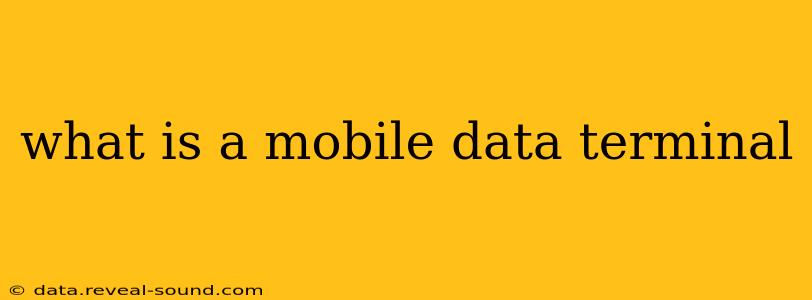A Mobile Data Terminal (MDT) is a mobile computing device used to collect, process, and transmit data in real-time while in motion. It bridges the gap between mobile operations and a centralized data system, allowing for seamless data exchange regardless of location. Think of it as a powerful, specialized computer designed for use in vehicles or other mobile environments, equipped with features optimized for demanding conditions. Unlike a simple smartphone, MDTs are built to withstand harsh conditions and integrate with various specialized peripherals.
What are the Key Features of a Mobile Data Terminal?
MDTs are characterized by a robust set of features tailored to their mobile applications:
- Ruggedized Design: Built to withstand vibrations, shocks, extreme temperatures, and other environmental factors common in mobile operations, ensuring reliable performance in challenging conditions.
- Wireless Connectivity: Typically equipped with multiple wireless communication options such as cellular (4G LTE, 5G), Wi-Fi, and sometimes satellite communication, ensuring constant connectivity even in remote areas.
- Specialized Peripherals: Often integrated with barcode scanners, RFID readers, GPS receivers, and other specialized input/output devices essential for data collection in various industries.
- Real-Time Data Processing: Capable of processing data quickly and efficiently, enabling immediate feedback and decision-making in dynamic environments.
- Data Security: Equipped with security features to protect sensitive data transmitted and stored on the device.
- User-Friendly Interface: Designed with intuitive interfaces to ensure ease of use for field personnel, even those with limited technical expertise.
- Long Battery Life: Essential for extended operation in mobile environments where access to power might be limited.
What are the Different Types of Mobile Data Terminals?
The specific type of MDT best suited for a particular application depends heavily on the industry and the nature of the tasks involved. Some common examples include:
- Vehicle-Mounted Terminals: These are usually ruggedized tablets or laptops securely mounted within vehicles, frequently used in transportation, logistics, and public safety.
- Handheld Terminals: Portable and smaller, these devices are often employed in inventory management, delivery services, and field inspections. They typically offer a balance between portability and functionality.
- Wearable Terminals: These are becoming increasingly popular and include devices such as smartwatches or ruggedized wearables used in applications where hands-free operation is critical, such as warehousing and manufacturing.
What Industries Use Mobile Data Terminals?
MDTs are utilized across a wide range of industries where real-time data collection and processing are essential:
- Transportation & Logistics: Tracking shipments, managing fleets, and optimizing delivery routes.
- Public Safety: Dispatching emergency responders, managing incidents, and providing real-time information.
- Field Service: Managing work orders, tracking technicians' location, and providing remote support.
- Retail: Managing inventory, tracking sales, and processing transactions.
- Healthcare: Tracking patients, managing medical supplies, and providing remote patient monitoring.
How Does a Mobile Data Terminal Work?
An MDT typically functions by collecting data from various sources through integrated peripherals (like barcode scanners or GPS). This data is then processed by the device and transmitted wirelessly to a central server or data management system. The central system analyzes the data, and often provides feedback or instructions back to the MDT in real-time. This closed-loop system allows for immediate responses and efficient operation.
What are the Benefits of Using a Mobile Data Terminal?
The use of MDTs offers several significant advantages:
- Improved Efficiency: Real-time data collection and processing streamlines workflows and reduces manual data entry.
- Enhanced Accuracy: Automated data capture minimizes human error and ensures data integrity.
- Better Decision-Making: Access to real-time information enables timely and informed decision-making.
- Increased Productivity: Streamlined processes and reduced paperwork lead to increased productivity.
- Reduced Costs: Improved efficiency and accuracy contribute to reduced operational costs.
What is the difference between an MDT and a rugged tablet?
While the lines can blur, the key difference lies in the focus. A rugged tablet is built to withstand harsh conditions, but it’s a general-purpose device. An MDT, however, is specifically designed and optimized for mobile data collection and transmission, often integrating specialized peripherals and software tailored to specific industry needs. A rugged tablet can be used as an MDT, especially in simpler applications, but a dedicated MDT is usually more feature-rich and efficient for complex tasks.
By understanding the capabilities and applications of Mobile Data Terminals, businesses can leverage these powerful tools to optimize their operations and gain a competitive edge. The future of MDTs looks bright, with continued advancements in technology promising even greater efficiency and functionality.
